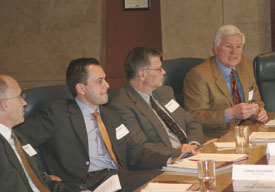 Patrick Pribyl discusses reasons construction industry clients are experiencing some insurance coverage rate relief.
Patrick Pribyl discusses reasons construction industry clients are experiencing some insurance coverage rate relief.He believes, in fact, that the biggest challenge that his company has in helping sustain the construction boom “is the continued increase in the frequency and severity of multi-party litigation.”
Simpson sees a positive trend, however, in that major insurance companies are hiring architects, engineers, geologists and others who understand the construction industry. “The underwriters,” said Simpson, “are going to be in a position to differentiate between those contractors that are putting forth that quality initiative and those that aren’t.”
In other positive developments, construction industry clients are enjoying some rate relief. The reason, Patrick Pribyl suggests, is that on the surety side, the industry as a whole made money in 2005, “the first time in five years.”
Grover Simpson attributes rate relief in part to “an emphasis on quality” by construction and engineering clients. As a result, claims experiences have stayed reasonably steady and even improved in some areas.
“When I think of insurance,” affirmed Jack Nix, “I also think of safety as being part of the equation.” He asserted that if the industry can improve quality and safety, it can keep the rates down. This, however, inevitably requires “trained leadership.”
“It’s quality,” agreed Simpson, “it’s safety, it’s owner relationships, it’s good sound contract documents, it’s saying no sometimes.”
 Roy Bash talks about current trends and issues in construction litigation. Casey Cassias, Ramin Cherafat and John Foudray consider the attorney's legal advice.
Roy Bash talks about current trends and issues in construction litigation. Casey Cassias, Ramin Cherafat and John Foudray consider the attorney's legal advice.Dennis Thompson confirmed that contractors were showing “more discipline in the last year” and turning down projects in which the risk factors were unacceptably high. “It’s difficult for some of us contractors who’ve grown up in this industry,” said Thompson. “It’s not an industry that’s prone to having the ability to say no when a client calls.”
As Simpson noted, one of the things that underwriters have quickly learned, particularly in the residential sector, is that they have to underwrite not only their client, the named insured on the policy, but also the owner of the project. In addition, they have to address the performance quality and the insurance quality of the subcontractors that are going to be working on behalf of the general contractor. “It’s not nearly as much about making money or the insurance rate,” said Simpson, “as it is about the integrity of the coverage for the project.”
Mike McClure asked how this supply dominated market environment is affecting new entrants to the construction business. Simpson responded that the big national underwriters have gravitated towards larger contractors. But he also sees a “very robust” regional construction insurance marketplace. A number of good underwriters, who are strong financially, have stepped up and said, “We want to serve almost exclusively the middle and lower tier construction firms, particularly the trade contractors.”
Patrick Pribyl sees a similar phenomenon on the surety side. “There are a number of very healthy, smaller companies,” he noted, “that are looking for that early entry or first entry for smaller contractor, infrequent user bonds.”
The question was then raised as to whether the improvements in product safety were tangible. Jack Nix believes they are. “Our trend over the last five years has been better each year,” he said of his own company. “I hope the whole industry is headed that way.” New technologies are driving the quality side of the equation, said Nix.